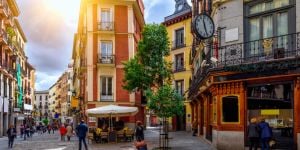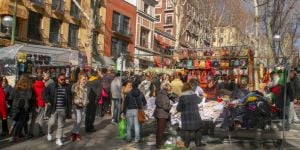
Madrid offers expats a great mix of cosmopolitan city and classic European charm. Daily life in Madrid is laid back and locals know how to enjoy themselves. Whether you're a night owl or looking for something low-key, expats in Madrid will find ample opportunities for an active social life. Not only that, but sunny days and ample parks mean you'll enjoy the outdoors year round.
Climate
There's a local saying that Madrid's weather is nine months of winter and three months of inferno. Take a closer look and you'll see Madrid enjoys tons of sunshine, distinct seasons, and generally moderate temperatures. In fact, due to its unique location on an arid plain, Madrid has around 2,500 sunny hours and less than 450mm of rain/snow per year.
Spring in Madrid is mild and, especially during April and May, has several wet days. Temperatures average from 11 °C (51 °F) in March to 17 °C (63 °F) during May.
Summer is dry with long, sunny days and temperatures around 32 °C (89.6 °F). In August, however, the city can be very hot with a few days of temps reaching 35 - 40 °C (95 - 104 °F).
Autumn in Madrid is similar to spring with mild temps and some rainy days. October is the wettest month of the year, averaging 83 mm (3.25 inches) of rain. Temperatures steadily decrease from around 21 °C (69 °F) in September to in 9.5 °C (49 °F) November.
Winter brings low temperatures but not much snow as Madrid sees only three snowy days per year. Temperatures average 6 - 8 °C (43 - 46 °F) with January being the coldest at 3 - 6 °C (37 - 43 °F).
Social life
Social life and relationships are an important part of daily life in Madrid. Locals are friendly and inquisitive. Time with friends or a family walk is a daily occurrence, the same with chatting with neighbors or the shopkeeper on the corner. If someone hears your accent, don't be surprised if they ask where you're from ' conversations like these are friendly and not invasive. Here are a few other things to know about Madrid's social scene.
Paseo: The paseo is a leisurely stroll and a very common evening pastime, no matter the weather. You'll see both families and groups of friends slowly walking in squares or along the tree-lined sidewalks, with no particular destination in mind.
Nightlife: There is no better city for those who enjoy staying out late. Many bars and pubs stay open until 4:00 am and nightclubs remain open until 6:00 or 7:00 am. There are many different nightlife areas, with an atmosphere and music to suit any taste.
Family: Madrid is a very welcoming place for families and not only because there are lots of family-friendly attractions. Children are welcomed everywhere and it's common to see kids dining late with parents in restaurants and cafes.
Useful link:
There is no shortage of things to do in Madrid! Be sure to read more about the city's ample leisure activities.
Nature
Although a bustling city of more than three million, almost every neighborhood in Madrid boasts some kind of park or garden where you can disconnect and enjoy some nature in the middle of the city. The three largest are El Retiro Park, Madrid Río, and Casa de Campo.
El Retiro: Madrid's crown jewel of parks is a true oasis in the middle of the city. Retiro park is filled with more than 15,000 trees, as well as countless fountains, statues, and gardens. The park is a perfect place to wander, lounge, or picnic and also features a lake with rowboats, several museums, and many cafes.
Madrid Río: This long strip of park and recreational space hugs both sides of the Manzanares river. Along its 12 km, there are running and bike paths as well as 17 different play areas for all ages. On the southern end, Madrid Río is capped by the Matadero, a former slaughterhouse complex that's been converted into a cultural space with art exhibits, food trucks, and artisanal markets.
Casa de Campo: Madrid's largest park was once the royal forest and hunting grounds of King Fernando VI. In 1931 however, it was donated to the city and has been open to the public ever since. Casa de Campo is a huge space (more than 1700 hectares) with an amusement park, lake, and zoo. It's a great place for running and also has a popular public pool.
Language
Like many cosmopolitan European cities, you'll find that many restaurants and businesses in central areas have English-speaking staff. With lots of international companies and a thriving expat community, it's possible to live in Madrid while learning only a few Spanish pleasantries.
However, to make life easier, you should try and expand your knowledge beyond buenos días and adios. Communication in government offices, using the public healthcare system, or even with your taxi driver are likely to take place in Spanish. Not to worry, you can get started with online classes or take advantage of one of Madrid's many Spanish language schools.
Useful Links:
We do our best to provide accurate and up to date information. However, if you have noticed any inaccuracies in this article, please let us know in the comments section below.








